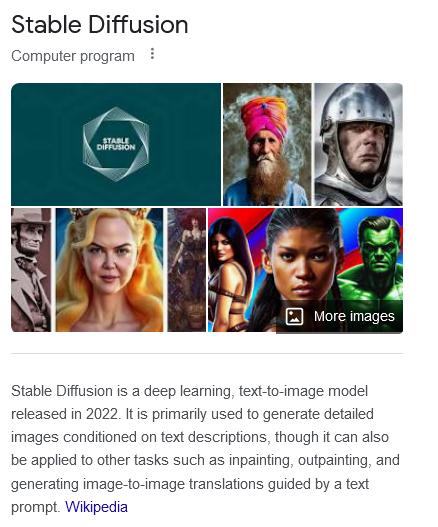Stable Diffusion Statistics 2023
- Stable Diffusion is a deep learning, text-to-image model released in 20221.
- It is primarily used to generate detailed images conditioned on text descriptions. However, it can also be applied to other tasks such as inpainting, outpainting, and generating image-to-image translations guided by a text prompt1.
- It was developed by the start-up Stability AI in collaboration with a number of academic researchers and nonprofit organizations1.
- Stable Diffusion is a latent diffusion model, a kind of deep generative neural network1.
- Its code and model weights have been released publicly, and it can run on most consumer hardware equipped with a modest GPU with at least 8 GB VRAM1.
- This marked a departure from previous proprietary text-to-image models such as DALL-E and Midjourney, which were accessible only via cloud services1.
- In October 2022, Stability AI raised US$101 million in a round led by Lightspeed Venture Partners and Coatue Management2.
- Stable Diffusion uses a kind of diffusion model (DM) called a latent diffusion model (LDM), developed by the CompVis group at LMU Munich1.
- Introduced in 2015, diffusion models are trained to remove successive applications of Gaussian noise on training images, which can be thought of as a sequence of denoising autoencoders1.
- Stable Diffusion consists of 3 parts: the variational autoencoder (VAE), U–Net, and an optional text encoder1.
- The model generates images by iteratively denoising random noise until a configured number of steps have been reached, guided by the CLIP text encoder pre-trained on concepts along with the attention mechanism, resulting in the desired image depicting a representation of the trained concept1.
- ai says it can double the resolution of a typical 512×512 pixel image in half a second. The second is significantly slower but more powerful. It uses the Stable Diffusion x4 upscale model and can quadruple an image’s resolution in between 20 and 40 seconds2.
- The development of Stable Diffusion was funded and shaped by the start-up company Stability AI1.
- The CompVis group at Ludwig Maximilian University of Munich1 released the technical license for the model’s.
- Development was led by Patrick Esser of Runway and Robin Rombach of CompVis, who were among the researchers who had earlier invented the latent diffusion model architecture used by Stable Diffusion1.
- Stability AI also credited EleutherAI and LAION (a German nonprofit that assembled the dataset on which Stable Diffusion was trained) as supporters of the project1.
- In October 2022, Stability AI raised US$101 million in a round led by Lightspeed Venture Partners and Coatue Management2.
- Stable Diffusion was benchmarked on the latest Nvidia, AMD, and even Intel GPUs to see how they stack up1.
- Nvidia’s GPUs rule the roost, with most software designed using CUDA and other Nvidia toolsets1.
- AMD GPUs were tested using Nod.ai’s Shark version 1.
- Getting Intel’s Arc GPUs running was a bit more difficult due to lack of support, but Stable Diffusion OpenVINO gave some very basic functionality1.
Stable Diffusion AI – What is it, Where, When built, and what user information demographics
Stable Diffusion AI has emerged as a groundbreaking technology with immense potential. This article aims to comprehensively understand Stable Diffusion AI, including its definition, development, and user information demographics.
Understanding Stable Diffusion AI
Stable Diffusion AI is an advanced machine learning technique that predicts information diffusion patterns in complex systems. It leverages deep neural networks to model and simulate the spread of information across networks, enabling accurate predictions and analysis.
The core principle behind Stable Diffusion AI lies in its ability to capture the intricate dynamics of information propagation, taking into account factors such as network topology, user interactions, and content characteristics. By analyzing these factors, Stable Diffusion AI can uncover patterns, trends, and insights related to the dissemination of information.
The Development of Stable Diffusion AI
Stable Diffusion AI has its roots in extensive research and development efforts conducted by leading experts in the field of artificial intelligence. The technique has been refined over the years, incorporating advancements in machine learning algorithms, data collection, and computing power.
The development of Stable Diffusion AI involved the creation of large-scale datasets comprising real-world information diffusion instances. These datasets were used to train deep neural networks, enabling them to learn and model the dynamics of information propagation accurately.
Applications of Stable Diffusion AI
The applications of Stable Diffusion AI are vast and diverse, with implications across various domains. Some notable applications include:
- Social Media Analysis
Stable Diffusion AI can be employed to analyze the spread of information on social media platforms. Understanding how information propagates through users, businesses, and organizations’ networks can gain valuable insights into user behavior, engagement, and influence.
- Marketing and Advertising
Marketers can leverage Stable Diffusion AI to optimize their advertising strategies. By predicting the diffusion patterns of promotional content, marketers can identify key influencers, target specific user segments, and enhance the reach and effectiveness of their campaigns.
- Epidemiology and Public Health
Stable Diffusion AI has the potential to revolutionize epidemiological studies and public health interventions. By modeling the spread of diseases or health-related information, researchers and policymakers can make informed decisions, develop effective intervention strategies, and minimize the impact of outbreaks.
- Information Security
Understanding the Diffusion of information is crucial in the field of cybersecurity. Stable Diffusion AI can help identify potential vulnerabilities in information networks, detect the propagation of malicious content, and develop robust defense mechanisms against cyber threats.
User Information Demographics
Stable Diffusion AI attracts a diverse user base consisting of professionals, researchers, and organizations from various industries. Researchers and academics utilize Stable Diffusion AI to advance their understanding of information diffusion and develop new methodologies. Businesses and marketers leverage the technology to gain insights into consumer behavior and optimize their marketing strategies.
The user information demographics of Stable Diffusion AI indicate a global interest and adoption of the technology. It has seen widespread usage in North America, Europe, and Asia, with a growing presence in other regions as well. Professionals from fields such as data science, marketing, sociology, and computer science form a significant portion of the user base.
Stable Diffusion AI represents a significant advancement in the field of artificial intelligence. With its ability to accurately model and predict the spread of information, this technology has far-reaching implications across various domains. Stable Diffusion AI offers valuable insights and optimization opportunities, from social media analysis to public health interventions. As its user base continues to expand globally, the potential for further innovation and applications of Stable Diffusion AI only continues to grow.
FAQs
- What makes Stable Diffusion AI unique? Stable Diffusion AI stands out due to its ability to capture the complex dynamics of information propagation in real-world networks, enabling accurate predictions and analysis.
- Can Stable Diffusion AI be applied to offline networks? Yes, Stable Diffusion AI can be applied to various types of networks, including offline networks such as transportation systems or interpersonal connections.
- Are there any limitations to Stable Diffusion AI? Like any technology, Stable Diffusion AI has limitations. It heavily relies on the quality and representativeness of the training data and may face challenges in modeling certain types of information diffusion.
- How can businesses benefit from Stable Diffusion AI? Businesses can leverage Stable Diffusion AI to gain insights into user behavior, identify influencers, optimize marketing strategies, and enhance the reach and impact of their campaigns.

A.I. is our Artificial Intelligence Bot that offers the best of all search marketing and paid advertising strategies here are AI Stratagems.

